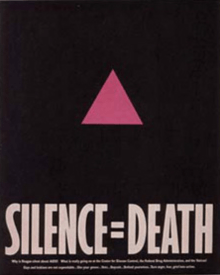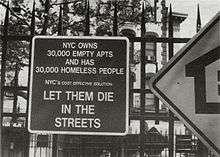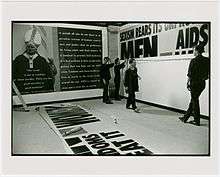Gran Fury
Gran Fury

Spawning from ACT UP (AIDS Coalition to Unleash Power) in 1988 Gran Fury was an AIDS activist artist collective from New York City consisting of 11 members including: Richard Elovich, Avram Finkelstein, Amy Heard, Tom Kalin, John Lindell, Loring McAlpin, Marlene McCarty, Donald Moffett, Michael Nesline, Mark Simpson and Robert Vazquez.[1][2] The collective mutually disbanded in 1995, a year prior to Mark Simpson’s death on November 10, 1996 from AIDS.[3] Gran Fury organized as an autonomous collective, describing themselves as a “...band of individuals united in anger and dedicated to exploiting the power of art to end the AIDS crisis.”[4] The contribution of recycling historical images of homoerotic pleasure contributed to the pictorial landscape of the AIDS activist movement. By recycling the title of the Plymouth sedan used by New York Police Department, Richard Meyer writes “[i]nscribed within the group’s name...” references “...both a subjective experience (rage) and a tool of State power (police squad cars), to both an internal sensation and an external force.”[4] Action, not art, was the aim of the collective.[5] Producing posters and agitprop in alliance with ACT UP to accompany the larger group’s demonstration, Adam Rolston and Douglas Crimp articulate how Gran Fury served as ACT UP’s “unofficial propaganda ministry and guerrilla graphic designers.”[6]
Methods

Gran Fury’s appropriation of “...commercial language for political ends became the hallmark of the artists involved.” By re-purposing, reframing and re-circulating images to underscore their political agenda, Gran Fury was able to reach a plurality of identities and communities.[6] AIDS does not discriminate, so there was an urgency to circulate information about this disease to the masses. Gran Fury member Loring McAplin observed the collectives mass-market ambition to “...fight for attention as hard as Coca-Cola fights for attention.”[4] Before social media, the collective's appropriation of mass-media language and use of various materials including: fliers, posters, stickers, T-shirts, billboards, photographs and postcards, simultaneously produced provocative, informative, stylish, political and satirical public projects.[7] By placing “...political information into environments where people are less accustomed to finding it…” articulates member Avram Finkelstein, catches the viewer off guard, revealing a new vocabulary and a new perspective on the AIDS health crisis.[6] An example of a work that provokes curiosity is their public intervention project where they swapped copies of The New York Times in coin-operated dispensers with their own The New York Crimes which resembled “...The New York Times but was full of information relating to the AIDS crisis.”[8]
Selected Works
"Let the Record Show"
In July 1987, William Olander (1950 - 1989),[6] an ACTUP member and curator of the New Museum in New York City, invited ACTUP to make an installation in "...the window by the museum entrance on Broadway".[8] A neon SILENCE=DEATH symbol crowned the display, with a pink triangle below. The pink triangle was appropriated from the Nazi marker for gay men imprisoned at death camps furthering the analogy between the AIDS crisis and the Holocaust. The neon piece became part of the New Museum’s permanent collection, and the SILENCE = DEATH graphic was widely disseminated through T-shirts, wheatpastes, and other printed ephemera.[9][10] The graphic was a reaction to an 1985 editorial in the New York Times written by William F. Buckley as well as the silence by the Reagan government.[11] Entitled Let the Record Show the work featured cardboard silhouettes of six public figures—televangelist Jerry Falwell, columnist William F. Buckley Jr., US Senator Jesse Helms, Cory Servaas of the Presidential AIDS Commission, an anonymous surgeon, and President Ronald Reagan—posited as AIDS criminals and set against a mural-sized photograph of the Nuremberg trials. Concrete slabs positioned under each figure offered evidence of their crimes, from misrepresentations of AIDS to ignoring the issue altogether as in the case of Reagan's notorious public silence, in the form of personal quotes. One reacted, for example, to a 1986 New York Times editorial by notorious arch-conservative William Buckley, who proposed that all persons with AIDS “...should be tattooed in the upper forearm, to protect common-needle users, and on the buttocks, to protect the victimization of other homosexuals.”[12]
Venice Biennale
In 1990, the group became notorious for its contribution to the Venice Biennale, a.k.a. the “Pope Piece”: “The artwork paired two billboard-sized panels: one coupled the image of the Pope John Paul II with a text about the church’s anti-safe-sex rhetoric; the other a two-foot-high erect penis with texts about women and condom use.” Typical of media indifference to the underlying issue, a May 28 New York Times report on the piece wrote "In fact, much of the talk about the Aperto among the hundreds of artists, curators, dealers and critics who have converged on this city during the last week has focused on two entries from the United States that have stirred interest more for their apparent capacity to shock than for anything else. Mr. Koons' entry is the first. The other, and for political reasons more important, is a set of posters by Gran Fury, a collective dedicated to issues involving AIDS. One poster features a photograph of the Pope flanked by a text condemning the Roman Catholic Church's policy toward sex and contraception. A week prior, Giovanni Carandente, the event's director of visual arts, said they considered excluding the poster. They told the Aperto's selection committee that they considered it to be blasphemous. Aggravating the problem was its proximity to a Gran Fury poster featuring a photograph of an erect penis (an image that would have caused more of a storm in the United States than a poster of the Pope). By Thursday, Mr. Carandente apparently reconsidered, and the posters were hanging at the Aperto. But on Saturday, the Vatican was reportedly deliberating about whether to ask the Italian Government to have the posters removed."[13]
Gran Fury, 80WSE, "Read My Lips"
"Gran Fury: Read My Lips" exhibition opening on January 31 from 6pm-8pm at NYU's 80WSE Galleries.
Exhibition Dates: January 31 - March 17, 2012
80WSE is proud to announce the opening of "Gran Fury: Read My Lips," the first comprehensive survey documenting the important AIDS activist art collective's work from 1987-1995. The exhibition, curated by Gran Fury and 80WSE Assistant Director Michael Cohen will run from January 31 - March 17, 2012. The exhibition consists of 15 pieces including give-away reproductions. Gran Fury has reconstituted all but two of the works from archival documentation for this survey with the assistance of the 80WSE staff.
Naming itself after the model of Plymouth automobile used by the New York City Police Department, Gran Fury made public projects that were simultaneously scathing, provocative, stylish and often quite funny. This exhibition conveys the collective's unique voice across a wide variety of media including billboards, postcards, video, posters and painting. Photographs and records from the period help convey the urgency of the early AIDS crisis that lead many into the streets to demand reforms that changed public policy and saved lives.
Gran Fury's work raised public awareness of AIDS and put pressure on politicians, while sparking debate in sites ranging from the Illinois Senate to the tabloid press of Italy. Bridging the gap between Situationist site-specific art strategies, post-modern appropriation and the Queer activist movement, Gran Fury has been influential to later practitioners. Their work opens up a broader spectrum of understanding about the political and collective art practices that flourished in downtown New York during the Eighties and Nineties.
An 88-page full-color catalogue designed by Gran Fury with mirroring double page cover reproductions will be published by 80WSE press in conjunction with the exhibition; it is the first major publication solely dedicated to their output. As a summary of its productive career, the book reprints historical interviews between Gran Fury and Robert Gober, David Deitcher and Douglas Crimp, as well as three never-before published conversations by Gran Fury from late 2010.
Reproductions of all the major works are included as well as documentation of ACT UP demonstrations and shots of Gran Fury's works installed site-specifically. In addition, images of the site-specific works' defacement by those responding to it, and rare archival images from high points in the collective's career such as the 1990 Venice Biennial controversy are included.
In the 80WSE Windows Gallery, Gran Fury will present a 25-foot window installation, facing Washington Square Park, produced specifically for this exhibition. The installation juxtaposes images of AIDS activist and anti-Gay protestors, encouraging viewers to viscerally experience the polarization in America over health-care issues related to AIDS during the late 1980s and providing historical context necessary for understanding how and why the images in this exhibition were produced.
Works in the Exhibition:
Many of Gran Fury's most important public works --- "Kissing Doesn't Kill," "Welcome to America," and "Women Don't Get Aids," will be reproduced in large-scale mural formats. There will also be a projection of the "Kissing Doesn't Kills" video public service announcements in the gallery along with never-before-seen outtakes. In addition, the exhibition includes several notable give-aways including "Men use Condoms" in an edition of 3000 and postcards from the "Read My Lips" series. Interspersed among these works will be texts and photos that recreate the social and political context which inspired AIDS activism and the demonstrations and actions where Gran Fury's graphic interventions were used.
A third part of this project will be a Gran Fury symposium with the members of Gran Fury interviewed by noted cultural theorist Andrew Ross. The event will held at the NYU/Steinhardt Art School's Einstein Auditorium at 34 Stuyvesant St. in the East Village on February 28 at 6:00 p.m.
The final aspect of the exhibition will be educational. Through a series of workshops Gran Fury will work with a select group of 15 NYU students from the Steinhardt Department of Art and Art Professions and the Gallatin Activism center, as well as 5 participants form the Village Lesbian, Gay, Bisexual and Transgender Center to think about the contemporary relationship of art and politics, and to produce activist and collective oriented art works in a manner that is strategically functional in the current decade. The workshop participants' artworks will be exhibited in March 2012 at the Village Lesbian, Gay, Bisexual and Transgender Center. The location of this exhibition is particularly meaningful, as it commemorates the Center's role as the locus of the original Act Up meetings that spawned Gran Fury.”(STEINHARDT,NYU)[14]

Practicing Art/Activism
Gran Fury purposefully intervened into public and advertising spaces to disrupt the flow of normal thoughts with their own agenda. Notably, most of their work was directly exhibited to the public outside of traditional art spaces through fliers, posters, and billboards. They often recycled their own images and texts to circulate their message beyond its initial viewers.
The collective aimed to push various individuals such as Ronald Reagan, New York Mayor at the time Ed Koch, and John Cardinal O'Connor to address the AIDS pandemic in a more practical, open way, as well as to inform the public on the importance of safer sex and clean needles. When asked about their approach of their work, Gran Fury said: “We want the art world to recognize that collective direct action will bring an end to the AIDS crisis. . . . Whenever we can, we steer the art world projects into public spaces so that we can address audiences other than museum-going audiences or the readership of art magazines.”[15] By the mid-1990s, Gran Fury found it hard to make simple works surrounding the AIDS pandemic, and started using more text making it hard for the group to relay messages as effectively as before. Gran Fury’s final piece was entitled “Good Luck… Miss You, Gran Fury,” and was produced in 1995, a year before the death of member Mark Simpson. In the piece, Gran Fury stated that the original agitprop art strategies they were using were ‘unable to communicate the complexities of AIDS issues'.[7]
Participants
The 11 main members of Gran Fury:
- Richard Elovich
- Avram Finkelstein
- Amy Heard
- Tom Kalin
- John Lindell
- Loring McAlpin
- Marlene McCarty
- Donald Moffett
- Michael Nesline
- Mark Simpson
- Robert Vazquez Pacheco
References
- ↑ Bottinelli, Silva (Nov 25, 2015). "Act Up New York: Activism, Art and the Aids Crisis, 1987-1993". Art Papers.
- ↑ "Conversation with Helen Molesworth and Gran Fury Members: Avram Finkelstein, Tom Kalin, Marlene McCarty, Robert Vazquez-Pacheco". arts.columbia.edu. Retrieved 2015-11-06.
- ↑ Crimp, Douglas (Nov 25, 2015). "Gran Fury Talks to Douglas Crimp". Art Forum.
- 1 2 3 Meyer, Richard (2002). Outlaw Representation: Censorship & Homosexuality in Twentieth Century American Art. Oxford: Oxford. pp. 225–237.
- ↑ Kabat, Jennifer (2012), Not Enough (149), Frieze Magazine
- 1 2 3 4 Kalb, Peter (2013). Art Since 1980: Charting the Contemporary. London: Laurence King Publishing. p. 112. ISBN 978 1 78067 326 4.
- 1 2 Slezak Karas, Laura (February 2008). "Gran Fury Collection 1987-1995" (PDF). The New York Public Library Humanities and Social Sciences Library Manuscripts and Archives Division. The New York Public Library. Retrieved November 9, 2015. line feed character in
|website=at position 28 (help) - 1 2 Kalb, Peter (2013). Art Since 1980: Charting the Contemporary. London: Laurence King Publishing. p. 112. ISBN 978 1 78067 326 4.
- ↑ Meyer, Richard (1995). Nina Felshin, ed. This is to Enrage You: Gran Fury and the Graphics of AIDS Activism. Seattle: Bay Press. pp. 63–64. ISBN 0-941920-29-1.
- ↑ Crimp, Douglas (2003). "Gran Fury Talks to Douglas Crimp". Artforum.
- ↑ "AIDS, Art and Activism: Remembering Gran Fury". Hyperallergic. Retrieved 2015-11-06.
- ↑ http://hyperallergic.com/42085/aids-art-activism-gran-fury/
- ↑ http://www.nytimes.com/1990/05/28/arts/review-art-venice-biennale-opens-with-surprises.html?pagewanted=all
- ↑ "Gran Fury Press Release - 80 Washington Square East Galleries - NYU Steinhardt". steinhardt.nyu.edu. Retrieved 2015-11-10.
- ↑ Gober, Robert http://bombsite.com/issues/34/articles/1382, BOMB Magazine Winter, 1991. Retrieved on May 31, 2013.
External links
- http://www.queerculturalcenter.org/Pages/GranFury/GFGllry.html
- "Let the Record Show..." (New Museum)
- Queer Cultural Center archive
- Collective retrospective essay
- "Gran Fury talks to Douglas Crimp" (Artforum)
- "When Political Art Mattered" (New York Times)
- Gran Fury collection, 1987-1995, Manuscripts and Archive, New York Public Library.
- 1990 AIDS PSA by Gran Fury (Media Burn Archive)
- http://digitalcollections.nypl.org/collections/gran-fury#/?roots=1:9eb36210-d7de-0132-ddc4-58d385a7bbd0&tab=navigation